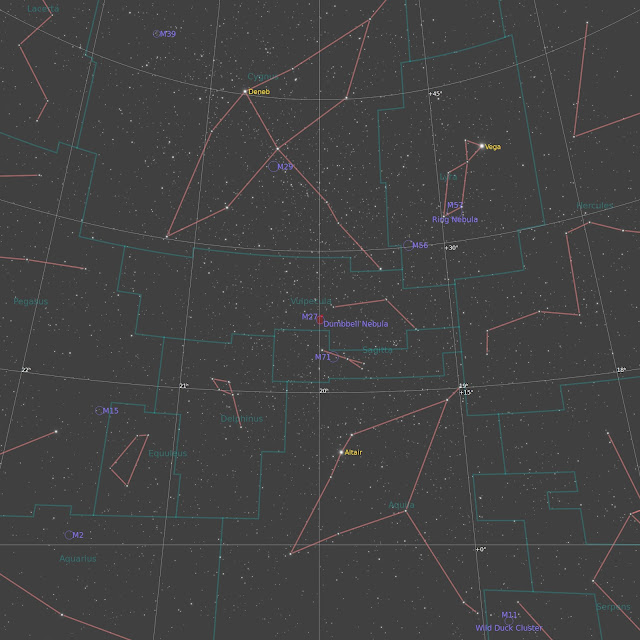A return to M27
Friday September 1st was a clear night, a clear night with a very bright (nearly full) Moon. I decided to use my Optolong L-eXtreme dual narrowband filter on M27. I imaged M27 without a filter under moonless skies back in May (click here for the related post). The L-eXtreme has 7 nm band passes in both Ha and Oiii. It would be interesting to see how it would perform with an almost full Moon. This is the resulting image.
 |
| M27 imaged with a dual narrowband filter on 9/1/2023. |
Setup went relatively smoothly. Started collecting images at 9:14 PM and stopped at 1:56 PM when clouds started to roll in (I wouldn't have been long until I lost the target to the trees anyways). I collected a total of 52 subs at 300 sec each. All pre and post processing was performed in PixInsight. A total of 45 subs were used after inspecting the frames with blink and using the Subframe Selector process. Processes used: Blink, Subframe Selector, WBPP (enabled2x Drizzle Integration and Autocrop), DBE, SPCC, BlurXTerminator, NoiseXTerminator, HT, and StarXterminator (unscreen stars). Stars: Curve Transformation (saturation), SCNR, and Correct Magenta Stars Script. Starless: Curve Transformation with mask (RGB/K), Curves Transformation with mask (saturation), SCNR, LHE, MMT, and Pixel Math to Screen stars back in. Finally, the image is significantly cropped in as this object is very small in my setup.
What is it?
Messier 27 (M270, also known as the Dumbbell Nebula, is a form of Emission Nebulae known as a Planetary Nebula. It has the distinction of being the first planetary Nebula ever discovered. A Planetary Nebula is the remnant of a star, like our Sun, that is too small to end its life as a Supernova. Instead, as the star reaches the end of its life, no longer capable of fusion, the star will lose its outer shells. A hot and very dense remnant known as a White Dwarf is left behind. Even though it is no longer capable of fusion, it is hot enough to ionize the expelled shells of gas.
How big is it?
This object has an angular distance of 8.0 x 5.7 arcminutes (1 degree is 60 arcminutes) on the night sky.
How far is it?
It is located about 1,400 light-years (ly) from Earth in the Constellation Vulpecula.
How to find it?
This object is relatively easy to find in a pair of binoculars, optical
finder scope, or telescope with a wide field of view. It is located in the
Constellation Vulpecula which is a dim constellation located within the Summer
Triangle. A nebula filter (like UHC or Oiii) filter can help improve
contrast and make the nebula stand out more from the background sky. Use
the finder chart below to help you locate it.
- Find the Summer Triangle (Vega, Deneb, & Altair).
- Method 1:
- Find Albireo (a beautiful visual target itself) which is the head of Cygnus the Swan or the base of the Northern Cross.
- Find Altair.
- M27 is the vertex of a imaginary triangle with Albireo and Altair as the other two vertices.
- Method 2: (Darker skies may be required)
- Find 13 Vulpeculae.
- Find Gamma Sagittae.
- M27 is the vertex of a imaginary triangle with 13 Vulpeculae and Gamma Sagittae as the other two vertices.
 |
| Finder Chart for M27 |





